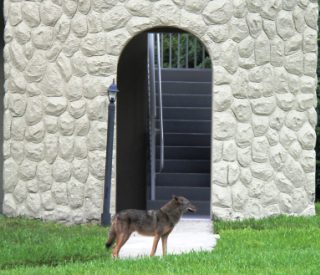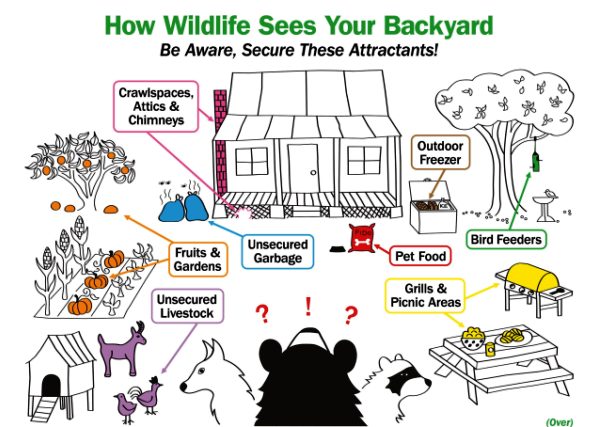|
Article Courtesy of The
Florida Weekly
By Robin F. Demattia
Published October 17, 2021
|
DURING THE PAST 18 MONTHS, MANY PEOPLE have moved to Florida and encountered
wildlife they’ve never seen before. And longtime residents might now be seeing
more wildlife in their backyards because the construction boom has taken away
some wildlife habitat. This is why it’s more important than ever to view “Nature
as Your Neighbor,” which is the topic of a Florida Fish and Wildlife
Conservation Commission presentation available free to homeowner associations,
nonprofit organizations and municipalities.
|
“Residents often
contact us about a conflict that they are experiencing with
wildlife,” says Catherine Kennedy Hannan, an FWC senior
wildlife assistance biologist. “But the conflict is based on
perception. The wildlife are doing what wildlife do —
looking for food, shelter, and mates — but those activities
can come into conflict with people.”
FWC receives around 12,000 calls every year about nuisance
wildlife, and about 40% of those are related to critters
such as bears and raccoons digging through someone’s garbage
cans.
At this time of the year, bear activity increases because
bears are fattening themselves up for winter. Ms. Hannan
says bears eat about 5,000 calories a day during the summer
but 20,000 calories a day in the fall.
Coyotes, though secretive and shy, pose a
particular risk to unsupervised small dogs and cats.
Raccoons like garbage, pet food, and vegetable gardens.
When birds like hawks are nesting and feeling protective,
they will swoop down toward people, often hitting the back
of their neck. |
|
A coyote is quite comfortable at an apartment complex
in south Lee County.
|
Foxes like to den under backyard sheds or front porch steps.
Bats love warm attics to roost and raise their young from April through
August.
Ms. Hannan says the two primary ways to resolve conflicts with wildlife are
to secure attractants and to scare away an animal, reinforcing its natural
fear of people. She suggests finding out if your municipality offers
wildlife-resistant garbage cans or otherwise securing garbage from curious
and hungry critters.
“Bears have one of the most highly developed senses of smell of all
animals,” she says, “They will get curious and investigate anything that
catches their attention.”
If an aggressive bird is nesting along an area you must walk, carry an
umbrella or erect a shade structure to block the hawk’s view.
Walk dogs on a short, fixed leash between dawn and dusk, because coyotes are
generally more active at night. Flash a porch light on and off and look
around before taking a pet out at night.
And keep pet food inside.
“Pet food is one of the top attractants because commercial pet food is
formulated to smell incredibly enticing,” says Ms. Hannan. “When left
outside, it attracts wildlife very effectively.”
One wildlife deterrent she likes is motion-activated water scarecrows,
especially when an animal has a well-defined path through a yard.
Motion-activated lights, however, only work once or twice, she says, and
when wildlife realizes there isn’t a threat behind that, they ignore it.
FWC considers an animal “nuisance wildlife” if it causes or is about to
cause property damage, presents a threat to public safety, or causes an
annoyance within, under or upon a building.
FWC issues different permits for the removal of animals such as venomous
reptiles, deer, bears, and pythons, but it also maintains a voluntary
registry of wildlife trappers.
Clarence “Butch” Smith, owner of Southern Trappers Nuisance Wildlife Removal
in Bonita Springs, is on that list.
He and his staff of four work with everything from squirrels and snakes to
armadillos and iguanas.
“I tell all my customers to expect to see something every time you walk
outside,” Mr. Smith says. “You never know where an animal can be.”
From February through November, he receives many calls about cane toads.
“They’re so dangerous to our domestic animals, and they’re taking a lot of
our native wildlife, like rabbits and turtles,” he says about the poisonous
toads that are also known as Buffo toads. This is one species he captures
and disposes of, rather than relocating.
But whenever he can, Mr. Smith relocates or rehabilitates animals, even
raising abandoned animals such as baby opossums. “My goal is to take care of
this environment because I was raised here. It’s always better to let the
animal be in nature,” he says,
Each area of southwest Florida has its own wildlife issues, he saysm adding
he does more python, armadillo and raccoon removal near Marco Island and
east Naples, while he finds more iguanas along the river in Bonita Springs.
He recommends that homeowners not put out rodenticide because other animals
could ingest it. He prefers other deterrents, such as laser pointers or bird
spikes on fences to scare off birds.
“Animals remember something good or something bad,” he says. “If you make
them uncomfortable, they won’t come back.”
For homeowners wanting to be good neighbors, Ms. Hannon reminds them that,
“Florida has a rich assortment of wildlife. Relocation is not the best solution
in many cases. Co-existence is really the most effective option.”
How to avoid attracting wildlife to your yard
Garbage: Use wildlife-resistant cans or secure garbage in a shed or
garage until the morning of pickup.
Pet food: Feed pets inside or remove bowls from lanais or outdoors after
your pet has eaten.
Outdoor freezers and food storage: Secure with locks.
Pets and livestock: Keep in a safe outbuilding or behind a secure,
electric fence. Keep pets on short leashes while out for a walk.
Crawlspaces, attics and chimneys: Patch holes and use mesh to prevent
entry.
Bird feeders: Use only enough seed for a day’s consumption. Bring in at
night and clean the area below a feeder.
Grills, smokers and picnic tables: Clean thoroughly with degreaser and
bleach, and store in an enclosed area.
Fruit-bearing trees and gardens: Harvest ripe fruit, remove fallen fruit,
and install motion-activated electric fencing.
|

